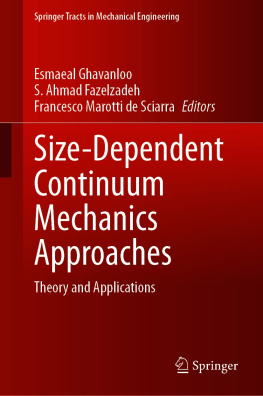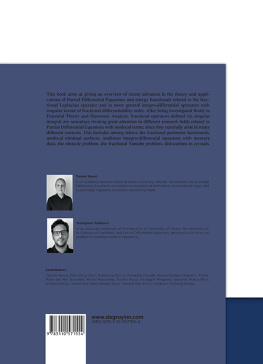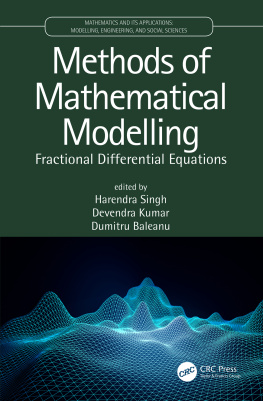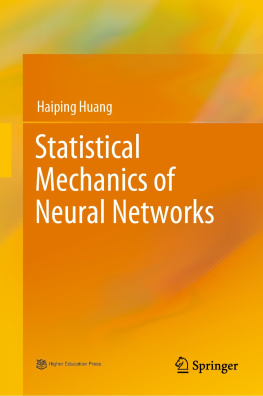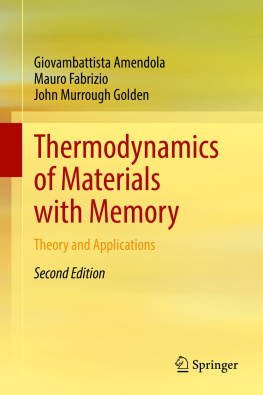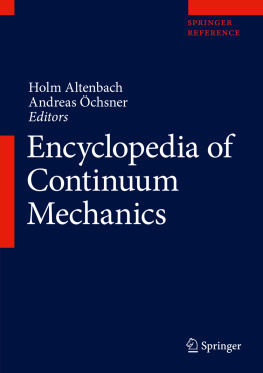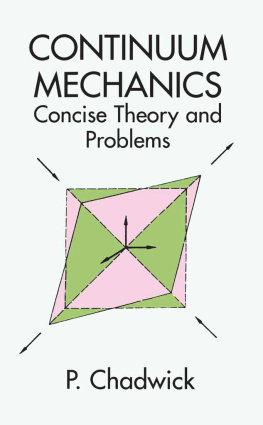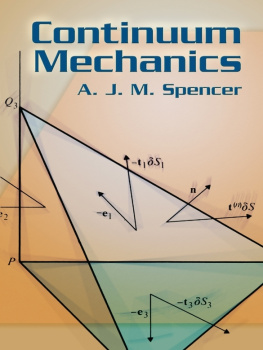Springer Tracts in Mechanical Engineering
Series Editors
Seung-Bok Choi
College of Engineering, Inha University, Incheon, Korea (Republic of)
Haibin Duan
Beijing University of Aeronautics and Astronautics, Beijing, China
Yili Fu
Harbin Institute of Technology, Harbin, China
Carlos Guardiola
CMT-Motores Termicos, Polytechnic University of Valencia, Valencia, Spain
Jian-Qiao Sun
University of California, Merced, CA, USA
Young W. Kwon
Naval Postgraduate School, Monterey, CA, USA
Francisco Cavas-Martnez
Departamento de Estructuras, Universidad Politcnica de Cartagena, Cartagena, Murcia, Spain
Fakher Chaari
National School of Engineers of Sfax, Sfax, Tunisia
Springer Tracts in Mechanical Engineering (STME) publishes the latest developments in Mechanical Engineering - quickly, informally and with high quality. The intent is to cover all the main branches of mechanical engineering, both theoretical and applied, including:
Engineering Design
Machinery and Machine Elements
Mechanical Structures and Stress Analysis
Automotive Engineering
Engine Technology
Aerospace Technology and Astronautics
Nanotechnology and Microengineering
Control, Robotics, Mechatronics
MEMS
Theoretical and Applied Mechanics
Dynamical Systems, Control
Fluids Mechanics
Engineering Thermodynamics, Heat and Mass Transfer
Manufacturing
Precision Engineering, Instrumentation, Measurement
Materials Engineering
Tribology and Surface Technology
Within the scope of the series are monographs, professional books or graduate textbooks, edited volumes as well as outstanding PhD theses and books purposely devoted to support education in mechanical engineering at graduate and post-graduate levels.
Indexed by SCOPUS, zbMATH, SCImago.
Please check our Lecture Notes in Mechanical Engineering at http://www.springer.com/series/11236 if you are interested in conference proceedings.
To submit a proposal or for further inquiries, please contact the Springer Editor in your region:
Ms. Ella Zhang (China)
Email: ella.zhang@springernature.com
Priya Vyas (India)
Email: priya.vyas@springer.com
Dr. Leontina Di Cecco (All other countries)
Email: leontina.dicecco@springer.com
All books published in the series are submitted for consideration in Web of Science.
More information about this series at http://www.springer.com/series/11693
Editors
Esmaeal Ghavanloo , S. Ahmad Fazelzadeh and Francesco Marotti de Sciarra
Size-Dependent Continuum Mechanics Approaches
Theory and Applications
1st ed. 2021

Logo of the publisher
Editors
Esmaeal Ghavanloo
School of Mechanical Engineering, Shiraz University, Shiraz, Iran
S. Ahmad Fazelzadeh
School of Mechanical Engineering, Shiraz University, Shiraz, Iran
Francesco Marotti de Sciarra
Department of Structures for Engineering and Architecture, University of Naples Federico II, Naples, Italy
ISSN 2195-9862 e-ISSN 2195-9870
Springer Tracts in Mechanical Engineering
ISBN 978-3-030-63049-2 e-ISBN 978-3-030-63050-8
https://doi.org/10.1007/978-3-030-63050-8
The Editor(s) (if applicable) and The Author(s), under exclusive license to Springer Nature Switzerland AG 2021
This work is subject to copyright. All rights are solely and exclusively licensed by the Publisher, whether the whole or part of the material is concerned, specifically the rights of translation, reprinting, reuse of illustrations, recitation, broadcasting, reproduction on microfilms or in any other physical way, and transmission or information storage and retrieval, electronic adaptation, computer software, or by similar or dissimilar methodology now known or hereafter developed.
The use of general descriptive names, registered names, trademarks, service marks, etc. in this publication does not imply, even in the absence of a specific statement, that such names are exempt from the relevant protective laws and regulations and therefore free for general use.
The publisher, the authors and the editors are safe to assume that the advice and information in this book are believed to be true and accurate at the date of publication. Neither the publisher nor the authors or the editors give a warranty, expressed or implied, with respect to the material contained herein or for any errors or omissions that may have been made. The publisher remains neutral with regard to jurisdictional claims in published maps and institutional affiliations.
This Springer imprint is published by the registered company Springer Nature Switzerland AG
The registered company address is: Gewerbestrasse 11, 6330 Cham, Switzerland
To my wife, Nazanin, and my son, Alireza, whose valuable support and patience have enabled me to complete this project, and to my parents for their encouragement, and finally to my mentor Prof. Hashem Rafii-Tabar, who gave me the opportunity to learn from him and work alongside him.
Esmaeal Ghavanloo
To my wife, Zahra, and my children, Ali and Yeganeh, for their patience and unwavering support.
S. Ahmad Fazelzadeh
To Angela for her unwavering support, patience, and understanding
Francesco Marotti de Sciarra
Foreword
The present book Size-Dependent Continuum Mechanics Approaches: Theory and Application is a collection of papers edited by Esmaeal Ghavanloo, S. Ahmad Fazelzadeh and Francesco Marotti de Sciarra. It covers a lot of interesting information about continuum mechanics approaches taking into account size-dependent effects. Approaches present in the book are mostly based on nonlocal theories, but also on micromorphic, peridynamic and gradient theories. Instead of the classical continuum mechanics with taking into account the material point and its infinitesimal surrounding, the alternative theories include also far-distance (beyond the infinitesimal surrounding) information. The majority of presentations in this book are related to contributions in this field of Ahmed Cemal Eringen (see, for example, W.H. Mller, Eringen, Ahmed Cemal, In H. Altenbach, A. chsner (eds), Encyclopedia of Continuum Mechanics, Springer, 2020, 860862).
It should be noted that the non-classical continuum mechanics approaches are much more complicated in comparison with the classical ones. Many examples are presented in the book for beams and one can follow the discussion in a simple manner having only basic knowledge on the Euler-Bernoulli beam theory. In addition, several applications are given and one can see that non-classical approaches are helpful if the structural size is very small. In this case, size effects are obvious and classical theories failed. The advanced theories allow the solution of new problems, but they have also disadvantages: the number of constitutive parameters increases. The estimation of the constitutive parameters is not trivial and several suggestions are discussed in the literature.

